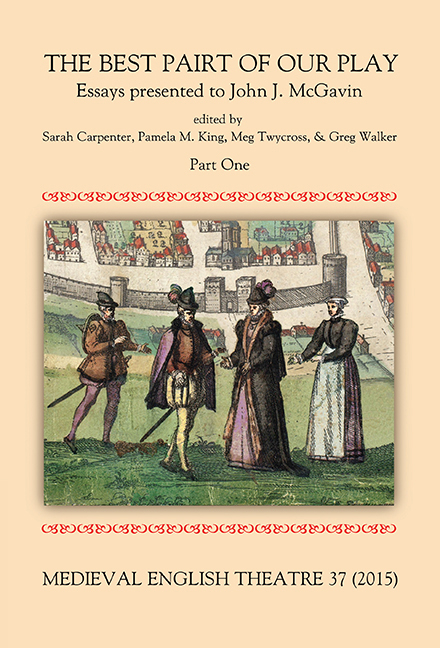Book contents
- Frontmatter
- Contents
- Epigraph
- Editorial
- In honorem John J. McGavin
- John J. McGavin: Bibliography
- The Places of Foolery: Robert Armin and fooling in Edinburgh
- George Bannatyne's ‘Sertane Mirry Interludis’, and Sir David Lyndsay's play
- The Linlithgow Interlude of 1540 and Lyndsay's Satire of the Thrie Estaitis
- Stage Directions in Lyndsay's Ane Satire of the Thrie Estaits
- The Dramatic Voice of William Dunbar
- How to Track a Bear in Southwark: a learning module
- The Digby Mary Magdalen in Performance: a merry peripeteia
- ‘Thus am I Rent on Rode’: taking apart the Towneley Crucifixion
- The Second Shepherds' Play: a play for the Christmas season
- ‘They did not come out of an Abbey in Lancashire’: Francis Douce and the manuscript of the Towneley Plays
- EDITORIAL BOARD (2015)
The Digby Mary Magdalen in Performance: a merry peripeteia
Published online by Cambridge University Press: 05 March 2016
- Frontmatter
- Contents
- Epigraph
- Editorial
- In honorem John J. McGavin
- John J. McGavin: Bibliography
- The Places of Foolery: Robert Armin and fooling in Edinburgh
- George Bannatyne's ‘Sertane Mirry Interludis’, and Sir David Lyndsay's play
- The Linlithgow Interlude of 1540 and Lyndsay's Satire of the Thrie Estaitis
- Stage Directions in Lyndsay's Ane Satire of the Thrie Estaits
- The Dramatic Voice of William Dunbar
- How to Track a Bear in Southwark: a learning module
- The Digby Mary Magdalen in Performance: a merry peripeteia
- ‘Thus am I Rent on Rode’: taking apart the Towneley Crucifixion
- The Second Shepherds' Play: a play for the Christmas season
- ‘They did not come out of an Abbey in Lancashire’: Francis Douce and the manuscript of the Towneley Plays
- EDITORIAL BOARD (2015)
Summary
In this essay I will look at the staging of the Digby play of Mary Magdalen and, drawing on my experience directing a production of the play, suggest that it works best when performed in the round with the audience in promenade.
Discussion of a medieval Theatre-in-the-Round frequently, and quite reasonably, begins with the notion of the stage as a mirror of the wider world and makes reference to the Hereford Mappa Mundi. There, represented in the circle of the World, and in the placing of the figure of Christ in Judgement at the apex, is the combination of the supposed facts of a created world and the eschatological circumstances that limited the actions and perceptions of Christian men and women of the period. Such schematic limitations can be seen also to be directly mirrored in the plan and the dramatic action of the Castle of Perseverance, except that that round, while mimicking the world map, was created specifically for a theatrical event. Its actual dimensions, even the disposition of its elements, may well remain a matter of debate and speculation, but it was either an astonishing innovation in practice or possibly based upon a familiar mode of theatrical production. In his Medieval Drama David Bevington imagined a similar round for the Digby Mary Magdalen. He identified all the major loci mentioned in the text but admitted that still more were required. This could have meant doubling the use of individual stages, a necessary device and a choice that directors have been known to make. I would only question his siting of ‘The Castle of Magdalen’ at the centre of the circular platea in imitation of the Castle of Perseverance. Its limited use hardly justifies that, and in what follows I propose an alternative solution.
In drawing attention to the other and various models of staging that might be available, I would include the Valenciennes sketch that pictures stagings for the Passion in what appears to have been a linear form. It is suggestive in its representation of multiple locations and was a main source for the plan that John McKinnell used for his production of Mary Magdalen in 1982. But, in light of the amount of movement presented through the play, the linear form creates as many difficulties as it solves.
- Type
- Chapter
- Information
- Medieval English Theatre 37The Best Pairt of our Play. Essays presented to John J. McGavin. Part I, pp. 105 - 118Publisher: Boydell & BrewerPrint publication year: 2015



